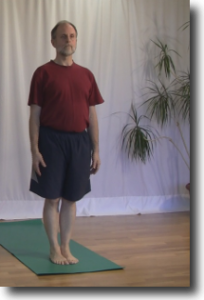Tadasana (Mountain Pose)
Tadasana is one of the few asanas that has two names. It is also called Samasthiti. Tadasana is Sanskrit for “Mountain pose” and Samasthiti is Sanskrit for “Equal Standing”. Samasthiti is a command to come to Equal Standing. You accomplish this command by standing in Tadasana.
A quick overview
- Stand tall with your weight centred over your feet. Your big toes touch and there is a small gap at your heels.
- Your legs are straight with the knee caps drawn up.
- Tuck your tailbone to keep the hips level.
- Lift the ribs, lengthen the spine, drop the shoulders down the back and let the arms rest at your sides.
- Gaze to the horizon with the head centred over the body.
And now the details
Start with the Feet
You start with the feet which are the foundation of all standing poses. It is important to get the foundation established first and then you can build a safe and stable posture from there.
Bring the big toes together. There should be a slight gap at the heels. The little toe sides of the feet should be almost parallel to each other. Gently lift the toes spread them apart and lower them back to the floor.
You need to balance the weight of the body between the front and back of the feet and between the left and right foot.
The best way you can do this is to lean forward as far as possible and then lean backwards as far as possible. Find the place between these two extremes where the weight is equally balanced between the front and back of the feet. Now you shift the weight to the left foot and then to the right foot. Again find the place between these two extremes where the weight is equally distributed between the left and right foot.
You will know that you have the weight correctly balanced between the four corners of the feet (front, back, left and right) if you feel like your body could easily move any direction. If you feel like you are wavering back and forth and side to side then you have your weight balanced over the centre of your feet.
Now that you have established a firm foundation with your weight centred over your feet it is now time to build on that foundation and move up to the legs.
On to the Legs
Now that the foundation has been established you need to focus on the legs.
The legs are straight but the knees are not locked. When you lock the knees they tend to hyperextend to the back and causes the two leg bones to connect. This can be painful and cause injury to the knees. Your challenge is to keep the leg straight and to not lock the knees. This will take a fair bit of practice to find the place where the legs are straight and keep them there.
Now you lift the knee caps up towards the hips by engaging the Quadriceps. This action will make the legs firm and add stability to the posture.
Once the legs are straight and the knee caps lifted it is time to move up to the hips.
The Hips are next
You like most people will probably have your hips tipped slightly forward. Visualize your hips as a bowl full of water. Most of the time when you are standing up you will be pouring some water out of the front of that bowl. That means that the hips are tipped forward slightly. We need to level the hips.
Tuck your tailbone in slightly. This action will cause you to tip that bowl (your hips) backwards slightly and bring it to a level position.
Now that you have the hips level, you move on to the torso.
Above the hips is the Torso
You should lift and expand the rib cage, lengthen the spine and keep the spine straight. Resist the temptation to arch the back. This is not a backbend, you should not arch the back, you should keep the spine long. You want to stand tall with the rib cage lifted and the shoulders down the back.
Roll the shoulders by bring the shoulders forward, then up towards the ears and finally take them down the back. This will help to get your shoulders in the correct position with the shoulder blades flat to the back.
Once your shoulder blades are flat to your back, the arms will be down by your side. Place the palms of your hands inwards towards the body and have the fingers pointing towards the floor.
Above all is the Head
With the shoulders down the back, centre the head over the torso. Some people have a tendency to lean the head forward. You should resist this temptation to move the head forward and focus on centring your head over your body. Move your head forward or backward until your ears are centred over your shoulders.
Raise or low your chin so that the head is level and gaze to the horizon.
So here we are
- The head is level and centred over the shoulders
- The shoulders are drawn back slightly and down the back away from the ears
- The back is nice and straight and centred over the hips
- The hips are level
- The legs are straight, and the knees are not locked
- The whole body is centred over the feet
You should be able to draw a vertical line from the ears through the body to the arches of the feet.
Previous Position (Sun Salute Article list)
Back to Sun Salute Article list
Next Position (Arms Up)




